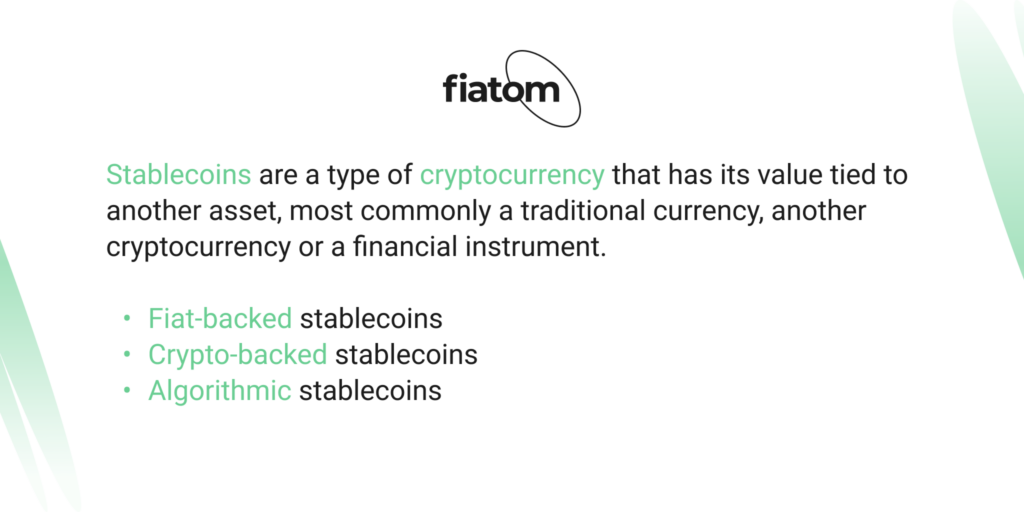Among sellers and moderate investors, there is a lot of discussion about cryptocurrencies with low volatility. Many of us have ever heard about stablecoins. What exactly are stablecoins? In the fast-changing world of cryptocurrencies, stablecoins have become a key innovation, offering a solution to the volatility of digital assets by providing the stability of traditional currencies. This article delves into the concept of stablecoins, explains how they function, and highlights some of the most popular stablecoins currently available in the market.
What are stablecoins?
Stablecoins are a type of cryptocurrency that has its value tied to another asset, most commonly a traditional currency, another cryptocurrency or a financial instrument. The main purpose of stablecoins is to maintain stability in their value and reduce price volatility by being linked to these assets. This creates an alternative for traditional cryptocurrencies. Many popular cryptocurrencies do not have this stability and are therefore considered less suitable for everyday transactions and more risky for investors.
Why stablecoins?
Many of the leading cryptocurrencies remain conventional cryptocurrencies, such as bitcoin. However, they are subject to price volatility, fluctuations of which can occur quite often, for several hours.
For traders who are determined to profit from the price difference, this is an advantage, but many investors seek long-term profits and lower risks. In addition, price volatility can negatively affect transactions, which is why many sellers are afraid to accept payments in cryptocurrencies, which may lose value soon after the transaction is completed. Thus, a cryptocurrency tied to a specific resource, which has a lower price volatility, becomes an excellent solution for both sellers and long-term investors.
Many cryptocurrency enthusiasts believe that the future belongs to digital currencies that operate independently of central banks. To meet this need, three main types of stable coins have been created based on their underlying assets.

Types of stablecoins
I. Fiat-backed stablecoins
Fiat-backed stablecoins are coins that are secured by reserves of fiat currency (traditional currence), such as the U.S. dollar, which helps maintain their value stability. These reserves are generally managed by independent custodians and are subject to regular audits; however, users should remain cautious about these assurances. Notable examples include Tether (USDT) and TrueUSD (TUSD), both pegged to the U.S. dollar.
Within the category of fiat-backed stablecoins, there are commodity-backed stablecoins, which are tied to the market value of commodities like gold, silver, or oil. These stablecoins typically hold the commodities through third-party custodians or invest in financial instruments that represent them. Such a stablecoin is Edelcoin (EDLC), which is fully backed by a basket of precious and base metals.
II. Crypto-backed stablecoins
Crypto-backed stablecoins are backed by other cryptocurrencies or a basket of cryptocurrencies. This ensures stability, as the value of the stablecoin is typically supported by an excess of collateral in the form of the backing cryptocurrency(s). A good example of a crypto-backed is Wrapped Bitcoin (WBTC), which is an ERC-20 token backed by Bitcoin (BTC).
While stablecoins offer the benefits of decentralization, there is still a risk of volatility due to the fluctuation in the value of their underlying assets.
III. Algorithmic stablecoins
Algorithmic stablecoins use algorithms and smart contracts to automatically adjust their supply based on market demand in order to maintain a stable price. For example, if the price of Terra (LUNA) rises above a certain level, more coins will be issued to bring the price back down. Conversely, if the price drops below a certain level, less coins will be available to increase the value.
In addition to these automatic adjustments, many algorithmic stablecoins also offer incentives for users to help maintain the peg. These incentives can include bonuses for placing bets, providing liquidity, or holding management tokens. This helps to ensure that the coin remains stable and attractive to investors.
There are various types of algorithmic stablecoins, each with different approaches to price stability. Some use a fixed supply, while others use dynamic supply adjustments. Some have built-in incentives, while others rely on external factors such as market demand. Each approach has its own advantages and challenges, and it’s important for investors to understand the risks and benefits before investing in any stablecoin.
Conclusion
Stablecoins are essential to the cryptocurrency ecosystem, providing a more stable environment for transactions. With their diverse forms catering to various needs and preferences, they alleviate concerns about volatility and foster broader adoption of digital currencies.
In essence, stablecoins act as a crucial link between the unpredictable realm of cryptocurrencies and the reliability of traditional fiat currencies. By maintaining a consistent value through different mechanisms—such as fiat reserves, commodities, or over-collateralized crypto assets—stablecoins enable users to transact with confidence and ease. They enhance liquidity in the cryptocurrency market, streamline everyday transactions, and offer more predictable value retention for investors.
As the digital currency landscape continues to evolve, stablecoins are poised to play an increasingly significant role, driving greater acceptance and integration of cryptocurrencies into the global economy. Their unique ability to merge the advantages of digital assets with the stability of fiat currencies makes them indispensable for both individuals and businesses navigating the complexities of finance.
WBTC, TUSD, USDC, and USDT are some of the most popular stablecoins based on market cap, according to CoinMarketCap.
You can check the current prices of these stablecoins on our website

